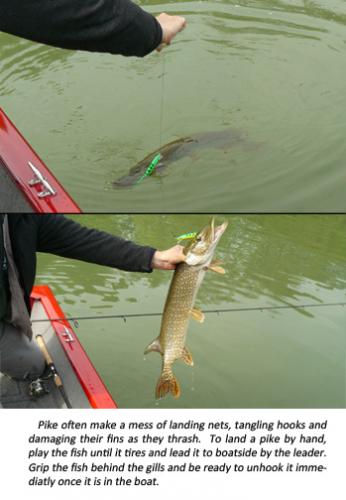Northern Pike: Stalking Michigan’s water wolf
As the ice thickens on Michigan lakes, anglers head out to catch a toothy predator. Pike are very popular with some anglers, but others avoid pike because of their sharp teeth and bony fillets. A few simple tips can turn you into a pike lover, too.
Anglers have a love-hate relationship with the northern pike, which is also referred to with a variety of colorful nicknames like water wolf, gator, jack, or (in the case of small pike) hammer handle. Pike are aggressive predators that are known for vicious strikes and powerful runs. They also make a delicious meal, but catching, handling, and preparing pike for the  pan requires some extra precautions.
pan requires some extra precautions.
Large live baits including suckers and chubs are fished below tip-ups in the winter to entice pike. Tip-ups are inexpensive handline devices that raise a flag after a pike takes the bait. When using live baits, anglers often allow pike to run with the bait and swallow it before setting the hook. This can be necessary when using a single treble hook and a large baitfish, but by using a quick-strike rig tied with two single hooks, anglers can set the hook immediately and avoid hooking pike deeply.
Although large pike do show a preference for large prey, smaller (3 to 5 inches) minnows can also be very effective and have the advantage of being less expensive and easier to rig. A single, long-shanked hook placed below the dorsal fin works well, either under a tip up or beneath a bobber in open water.
Regardless of your rig, tooth-proof leaders are a must when fishing live bait. Pre-rigged steel leaders and quick strike rigs are widely available, but some anglers prefer titanium, fluorocarbon, or braided leaders. Heavy fluorocarbon (at least 50-pound test) has the advantage of being clear, but it is also stiff. Braided leaders are supple, making them easier to work with and giving your bait a more natural action. Opinions differ on using braided line for pike, and some brands are not tough enough to hold up to a pike’s teeth. Use common sense; if you have difficulty cutting line with nail clippers, it will probably hold up to most pike.
I have been using long-shanked single hooks paired with 35-pound braided line made of Kevlar® for twenty years without a single bite-off. Most braided “superlines” on the market now are made of less abrasion-resistant materials that do not hold up as well as bulletproof Kevlar®. With a little searching online, you can find a lifetime supply for less than $20.
Handling pike takes some practice and a good measure of caution. Pike are very slippery and have a habit of lying motionless for a time before exploding in a frenzy that can easily lodge stray hooks in an angler’s hand. To get a handle on pike, grip the fish across the back, placing the thumb and forefinger just inside the upper portion of the gill covers. This helps to keeps fingers away from teeth and sharp gill rakers while hooks are removed with needle-nosed pliers. Some anglers also use jaw spreaders or protective gloves when unhooking pike.
Cleaning pike is similar to cleaning other fish, but fillets contain a row of y-bones that can be removed either before or after cooking. If you remove y-bones before cooking, you will be left with two boneless fillets and two long strips of bony meat that can be ground to make fish patties or pickled to soften the bones. Some anglers avoid pike, but with a little extra work you will be rewarded with an excellent meal of firm, tasty meat that is particularly good when baked with fresh herbs and vegetables.



 Print
Print Email
Email



